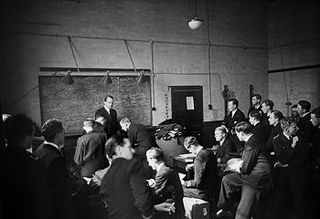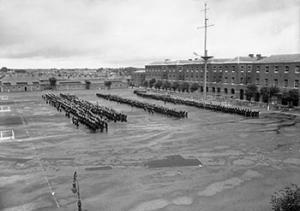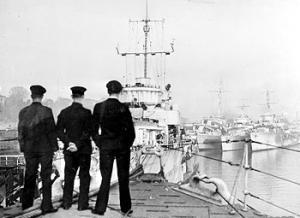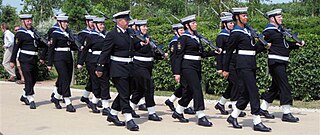The Royal Radar Establishment was a research center in Malvern, Worcestershire in the United Kingdom. It was formed in 1953 as the Radar Research Establishment by the merger of the Air Ministry's Telecommunications Research Establishment (TRE) and the British Army's Radar Research and Development Establishment (RRDE). It was given its new name after a visit by Queen Elizabeth II in 1957. Both names were abbreviated to RRE. In 1976 the Signals Research and Development Establishment (SRDE), involved in communications research, joined the RRE to form the Royal Signals and Radar Establishment (RSRE).
HMS Collingwood is a stone frigate of the Royal Navy, in Fareham, England. It is the lead establishment of the Maritime Warfare School and the largest naval training organisation in Western Europe. The Maritime Warfare School is a federated training establishment incorporating HMS Excellent, the Defence Diving School, the RN Physical Training School, the School of Hydrography and Meteorology in Plymouth and the Royal Marines School of Music in Portsmouth Naval Base.

HMAS Assault is a former Royal Australian Navy (RAN) training centre that was in use during World War II, located at Nelson Bay in the Mid North Coast region of New South Wales, Australia.

HMS Vernon was a shore establishment or "stone frigate" of the Royal Navy. Vernon was established on 26 April 1876 as the Royal Navy's Torpedo Branch also known as the Torpedo School, named after the ship HMS Vernon which served as part of its floating base. After the First World War, HMS Vernon moved ashore, taking over the Gunwharf site, where it continued to operate until 1 April 1996, when the various elements comprising the establishment were split up and moved to different commands.

HMS President is a "stone frigate", or shore establishment of the Royal Naval Reserve, based on the northern bank of the River Thames near Tower Bridge in Wapping and is in the London Borough of Tower Hamlets.
HMS Cricket was the name given to a Royal Navy shore establishment on the River Hamble from 1943 to 1946. This name was previously used by the Insect class gunboat HMS Cricket that was scrapped in 1942.

HMS Mercury was a shore establishment of the Royal Navy, and the site of the Royal Navy Signals School and Combined Signals School. There was also a subsidiary branch, HMS Mercury II.

HMS Imperieuse was the name given to a floating Training establishment of the Royal Navy during the Second World War.

HMS St Vincent was a shore establishment of the Royal Navy, located in London during the 1990s.

HMS St Vincent was a shore establishment of the Royal Navy, located in Gosport,.
HMS Abatos was a Royal Navy Shore establishment responsible for the planning of PLUTO, the undersea pipeline that supplied the allied troops with fuel during the liberation of Europe in 1944, after D-Day. There was another PLUTO training establishment at Tilbury, under the name HMS Abastor.
HMS Ferret is a training unit of the Royal Naval Reserve based at the Joint Intelligence Training Group (JITG), Chicksands in Bedfordshire.

HMS Ferret was a shore establishment and naval base of the Royal Navy during the Second World War, located in Derry. It was given a ship's name as a stone frigate.

HMS Forward is a Royal Naval Reserve unit located in Birmingham, England, close to St. Andrews football stadium. It has a crew of nearly 100 naval and marine reservists, in addition to a handful of full-time staff. The Birmingham University Royal Naval Unit, the Defence Technical Undergraduate Scheme 'Taurus Squadron' and a detachment of the Royal Marine Reserves Merseyside are also located on the site. The ship is particularly unusual in that it is situated 80 miles from the sea.
HMS Standard was a British Royal Navy shore establishment between 1942 and 1945. Situated well away from the sea near Kielder in Northumberland, the base was an assessment and rehabilitation centre for naval personnel diagnosed with personality disorders.

HMS Newt was a shore establishment of the British Royal Navy during World War II, based at Newhaven, East Sussex.

HMS Elfin was a torpedo recovery vessel built for the Royal Navy. She was built by J. Samuel White & Company, East Cowes, Isle of Wight, was launched on 20 November 1933 and commissioned on 16 January 1934. She was builder's number 1754. Her home port was the Navy's torpedo trials establishment HMS Vernon, and she was based at Portland. A sistership, Redwing, was constructed under builder's number 1753 and was stationed at HMS Defiance, Devonport. Elfin was renamed Nettle during the Second World War, and was later sold for scrapping. She survived in mercantile service, and has been preserved.

HMS Osprey was an anti-submarine training establishment located at the Isle of Portland, Dorset, England. It was active between 1924 and 1941, and again from 1946 to 1999. The helicopter station RNAS Portland formed part of the establishment from 1959 to 1999.
The Senior British Naval Officer, Suez Canal Area was an administrative shore based command appointment of the Royal Navy established during World war II who was responsible superintending the naval base HMS Stag at Ismailia, Egypt it was a sub-command of the East Indies Station from 1939 to 1941 then the Mediterranean Fleet until 1942.















